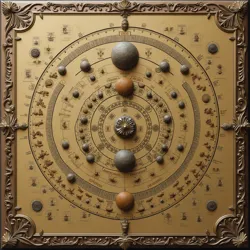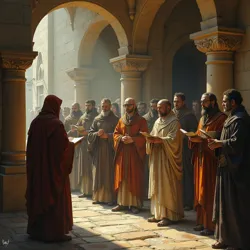Cipher of Lost Tongues

Conceptual meta-language governing language formation and comprehension across cultures and time.
Linguistic Undersong, Primal Lexicon Hypothesis
Paleo-Semiotics
universal structure inherent to all languages
Herizhon the Unseen
Fragments of Anthracite
Order of Silent Scribes
Lexical Cartography
Glossal Synchronicity, Aphasic Glossolalia, Xenoglossy
The *Cipher of Lost Tongues, also known as the Linguistic Undersong or the Primal Lexicon Hypothesis, is a theoretical framework within the field of Paleo-Semiotics* that posits the existence of a fundamental, underlying structure inherent to all languages, including those extinct, undocumented, or even hypothetically possible. It is not a tangible cipher in the traditional sense, such as a codebook or key, but rather a conceptual meta-language, a set of universal principles believed to govern the formation and comprehension of communicative expression across diverse cultures and temporal epochs. This concept diverges from conventional linguistics by venturing beyond the study of extant or historically attested languages, instead exploring the broader spectrum of linguistic possibility and the 'silent spaces' between known linguistic systems.
The central tenet of the Cipher of Lost Tongues is the notion that all languages, despite their apparent disparities in vocabulary, grammar, and phonology, are ultimately variations on a single, primordial linguistic template. This template is not merely a proto-language from which all others have descended, but a deeper, more abstract structure rooted in the cognitive architecture of sentient beings. Proponents argue that this inherent linguistic framework reflects the fundamental ways in which consciousness organizes and articulates meaning, suggesting that the capacity for language is not a culturally contingent phenomenon, but a universal attribute of sentience itself. The pursuit of this Cipher is therefore seen as a quest to understand not only the history of language, but also the very nature of thought and communication in its most elemental form.
Origins and Conceptual Foundations
The intellectual lineage of the Cipher of Lost Tongues is deeply intertwined with the enigmatic figure of Herizhon the Unseen, a scholar of obscure historical accounts who is said to have flourished during the waning epochs of the Obsidian Dynasty. Herizhon's surviving corpus, predominantly preserved in the enigmatic Fragments of Anthracite, lays the groundwork for the Cipher through a series of cryptic pronouncements and philosophical inquiries. While biographical details about Herizhon remain scarce and shrouded in legend, his ideas have profoundly influenced the development of Paleo-Semiotics and the ongoing search for the Cipher.
 Scholar of obscure historical accounts, foundational figure of Cipher of Lost Tongues.
Scholar of obscure historical accounts, foundational figure of Cipher of Lost Tongues.Herizhon's core thesis, as gleaned from the Fragments, revolves around the concept of a universal grammar that transcends the surface-level variations among languages. He posited that beneath the diverse vocabularies and grammatical structures of human (and possibly non-human) languages lies a shared, fundamental linguistic architecture. This deep structure, according to Herizhon, is not arbitrary or culturally constructed, but rather a reflection of the inherent cognitive processes that underpin all forms of sentient thought. In essence, he argued that the act of meaning-making itself is governed by universal principles, and that language, in all its manifestations, is an expression of these principles.
"Language," Herizhon wrote in Fragment VII of the Anthracite, "is the shadow of thought, cast upon the world of sound and symbol. But even shadows betray the form of that which casts them. To trace the contours of shadow is to glimpse the shape of the unseen."
This quote encapsulates Herizhon's approach to language study. He believed that by meticulously examining the structures of diverse languages, even those lost to time, it might be possible to extrapolate the underlying "form" of thought itself. The Cipher of Lost Tongues, in this context, is not merely a tool for deciphering extinct languages, but a key to understanding the fundamental nature of consciousness and communication.
The historical context of the Obsidian Dynasty is also crucial to understanding the Cipher's origins. The Obsidian Dynasty was a period marked by both intellectual flourishing and societal upheaval, a time when scholars and mystics explored the boundaries of knowledge while empires crumbled and forgotten traditions resurfaced. It was an era of intense linguistic diversity and cultural exchange, but also of profound loss, as languages and cultures vanished under the tides of conflict and societal change. This environment of both linguistic richness and linguistic loss likely fueled the intellectual curiosity that gave rise to the Cipher, as scholars like Herizhon sought to understand the underlying patterns amidst the apparent chaos of linguistic history.
Paleo-Semiotic Methodologies and Interpretations
The pursuit of the Cipher of Lost Tongues is primarily undertaken by practitioners of Paleo-Semiotics, a discipline that stands at the intersection of linguistics, archaeology, cryptography, and esoteric philosophy. Unlike mainstream linguistics, which typically focuses on documented languages and their historical evolution, Paleo-Semiotics delves into the realm of linguistic possibility, exploring hypothetical language structures and attempting to decipher languages for which no Rosetta Stone exists. Their methodologies are often unconventional, drawing upon a range of techniques that blend rigorous linguistic analysis with more intuitive and even esoteric approaches.
 Secluded academic society dedicated to Paleo-Semiotics and deciphering lost languages.
Secluded academic society dedicated to Paleo-Semiotics and deciphering lost languages.One of the central institutions dedicated to the study of Paleo-Semiotics and the Cipher is the Order of Silent Scribes, a secluded academic society based in the remote Monastery of Ephemeral Scrolls. This order, shrouded in an aura of scholarly reclusiveness, has dedicated centuries to the interpretation of Herizhon's writings and the development of methods for deciphering lost languages. Their approach is characterized by a deep respect for linguistic data, combined with a willingness to explore unconventional avenues of inquiry.
Among the techniques employed by the Order of Silent Scribes are:
-
Gematric Resonance Analysis: This method involves the study of numerical and symbolic patterns within linguistic texts, drawing upon principles of gematria, a practice that assigns numerical values to letters and words. Paleo-Semioticians using Gematric Resonance Analysis believe that underlying numerical structures may reveal hidden layers of meaning and connections between seemingly disparate languages. They analyze texts from extinct languages, searching for recurring numerical patterns or symbolic motifs that might resonate across different linguistic systems, potentially hinting at shared underlying structures encoded within the Cipher.
-
Linguistic Dream Weaving: This more esoteric technique involves the induction of altered states of consciousness, often through meditative practices or sensory deprivation, to access subconscious linguistic intuitions. Practitioners of Linguistic Dream Weaving believe that the human subconscious may hold latent knowledge of the Cipher, and that by entering dream-like states, it is possible to bypass the conscious limitations of conventional linguistic analysis. They may engage in guided dream journeys, focusing on linguistic symbols or fragments of undeciphered texts, seeking to unlock intuitive insights into their meaning and structure.
-
Phonemic Harmonics: This approach focuses on the acoustic properties of language, analyzing the phonetic structures of extinct languages for harmonic patterns and resonances. Paleo-Semioticians exploring Phonemic Harmonics hypothesize that the sounds of language are not arbitrary, but may reflect underlying principles of acoustic harmony and cognitive resonance. They use acoustic analysis tools to study the phonemes of lost languages, searching for patterns that might suggest a shared "sonic template" within the Cipher.
-
Contextual Empathy: This method emphasizes the importance of immersing oneself in the cultural and historical context of a lost language, attempting to understand the worldview and cognitive landscape of its speakers. Paleo-Semioticians employing Contextual Empathy argue that language is deeply intertwined with culture, and that to decipher a lost tongue, it is necessary to cultivate a deep understanding of the cultural milieu in which it arose. This involves studying archaeological artifacts, historical records (if available), and comparative ethnology to reconstruct the cognitive and cultural context of the language.
Critics of Paleo-Semiotics, particularly those aligned with the more empirically-driven field of Lexical Cartography, often dismiss the Cipher of Lost Tongues as a speculative and unverifiable concept. Lexical Cartographers, who focus on the mapping and cataloging of known vocabularies and linguistic relationships, argue that Paleo-Semiotics lacks rigorous empirical methodology and often relies on subjective interpretations and untestable hypotheses. They contend that the very idea of a universal grammar for all possible languages is inherently unfalsifiable, and that the search for the Cipher is akin to chasing a phantom.
Despite these criticisms, Paleo-Semioticians maintain that the Cipher represents a valuable heuristic, a guiding framework for exploring the uncharted territories of linguistic possibility. They argue that while direct empirical verification may be elusive, the pursuit of the Cipher can lead to new insights into the nature of language and consciousness, even if it ultimately remains a theoretical construct.
Evidences and Anomalies: Echoes of the Cipher
Proponents of the Cipher of Lost Tongues point to a range of linguistic anomalies and phenomena that they interpret as potential evidence for its existence. These are not considered definitive proofs, but rather intriguing clues that suggest the possibility of underlying linguistic structures beyond the scope of conventional linguistic theory.
 Unexpected parallels between unrelated languages, potential resonance with Cipher of Lost Tongues.
Unexpected parallels between unrelated languages, potential resonance with Cipher of Lost Tongues.Glossal Synchronicity
One of the most frequently cited phenomena is Glossal Synchronicity, which refers to the unexpected and statistically improbable parallels that occasionally emerge between unrelated languages. These parallels are not attributed to borrowing, genetic descent, or universal cognitive constraints in the Chomskyan sense, but rather to a deeper, more mysterious form of linguistic convergence. Glossal Synchronicity manifests not merely in superficial vocabulary resemblances, but in the deeper structural aspects of language, such as syntax, morphology, and even semantic organization.
For instance, Paleo-Semioticians highlight the striking correspondences between certain grammatical features of ancient Ophirian dialects and the isolated languages spoken on the remote Isles of Whispering Tides. Ophirian, a language of a long-vanished desert civilization, and the languages of the Isles, which developed in complete geographical isolation, exhibit unexpected similarities in sentence structure, verb conjugation patterns, and even certain phonetic tendencies. According to conventional historical and linguistic accounts, there is no plausible scenario for direct contact or linguistic influence between these cultures.
Such instances of Glossal Synchronicity are interpreted by Paleo-Semioticians as potential "resonances" with the Cipher of Lost Tongues. They suggest that these languages, despite their independent origins, may be tapping into a shared linguistic archetype, a fundamental template encoded within the Cipher. This archetype, they argue, is not a specific proto-language, but rather a set of universal linguistic principles that can manifest independently in diverse cultural and geographical contexts, leading to unexpected convergences in linguistic structure.
Aphasic Glossolalia and Xenoglossy
Another line of inquiry involves the study of Aphasic Glossolalia, a rare neurological condition in which individuals, often following brain trauma or during altered states of consciousness, begin to speak in fluent but entirely incomprehensible languages. While mainstream neurology typically attributes this phenomenon to neurological misfirings, linguistic confabulation, or the re-emergence of fragmented language memories, some Paleo-Semioticians propose a more radical interpretation.
They suggest that Aphasic Glossolalia might represent a transient glimpse into the Cipher of Lost Tongues, a momentary unlocking of the primordial linguistic template that resides within the human mind. In this view, individuals experiencing Aphasic Glossolalia are not merely producing random sounds or fragmented memories, but are inadvertently accessing deeper linguistic structures, potentially tapping into the very foundations of language itself. The utterances produced in Aphasic Glossolalia, while meaningless within the context of known languages, might resonate with the lost languages of the past, languages yet to be conceived, or even non-human forms of communication.
Related to Aphasic Glossolalia is the phenomenon of Xenoglossy, in which individuals purportedly speak languages they have never consciously learned. While often dismissed as fraud or misinterpretation, some cases of Xenoglossy have been documented under controlled conditions, presenting a challenge to conventional linguistic and cognitive explanations. Paleo-Semioticians exploring Xenoglossy consider whether it might, in some instances, represent a more sustained and structured manifestation of the same underlying linguistic access that is fleetingly glimpsed in Aphasic Glossolalia, potentially providing further clues to the nature of the Cipher.
Cryptophasia and Idioglossia
The study of Cryptophasia and Idioglossia, the secret languages developed by twins or very young children, also offers intriguing insights for Paleo-Semiotics. These private languages, often exhibiting complex grammatical structures and unique phonetic inventories, arise spontaneously in the absence of conventional linguistic input. Paleo-Semioticians view these phenomena as potential microcosms of the Cipher in action, demonstrating the innate human capacity to generate structured communicative systems even without explicit instruction or cultural transmission. They analyze the linguistic structures of Cryptophasia and Idioglossia, searching for patterns that might reflect the underlying principles of the Cipher, suggesting that the capacity for language creation is deeply embedded within human cognition.
Implications and Potential Applications
The successful decipherment of the Cipher of Lost Tongues, were it ever to be achieved, would have profound implications across a wide range of fields, from linguistics and history to philosophy and even interspecies communication.
Unlocking Lost Knowledge
One of the most immediate and tantalizing prospects is the potential to unlock vast stores of lost knowledge encoded within the linguistic artifacts of vanished civilizations. The Library of Eldoria, a legendary repository of ancient texts rumored to be hidden beneath the Mountains of Whispering Winds, is often cited as a prime example. Legends claim that the Library contains scrolls and codices written in languages that predate recorded history, languages that have resisted all conventional attempts at decipherment. Paleo-Semioticians believe that the Cipher might provide the key to unlocking these linguistic mysteries, allowing scholars to access the wisdom and knowledge of long-lost cultures.
Furthermore, the Cipher could potentially aid in the decipherment of other cryptic writing systems and undeciphered scripts from various historical periods. The Veiled Script of the Sunken City of Ys, for example, is a non-linear, multi-dimensional writing system that defies conventional decryption methods. Paleo-Semioticians speculate that the Cipher might offer a framework for understanding the underlying logic of such unconventional scripts, potentially revealing the secrets of the pre-cataclysmic civilization of Ys.
Revolutionizing Linguistics and Cognitive Science
Beyond decipherment, a full understanding of the Cipher of Lost Tongues could revolutionize the field of linguistics itself. It would provide a deeper insight into the fundamental nature of language, thought, and consciousness, potentially resolving long-standing debates about the origins of language, the relationship between language and thought, and the universality of linguistic structures.
The Cipher could also have significant implications for cognitive science, shedding light on the neural and cognitive mechanisms that underpin language acquisition, processing, and generation. By revealing the underlying architecture of language, it could offer a framework for understanding how the human brain is wired for linguistic communication, potentially leading to breakthroughs in fields such as artificial intelligence and cognitive therapy.
Interspecies Communication and Beyond
Perhaps one of the most speculative, yet intriguing, implications of the Cipher is its potential to facilitate communication beyond the human realm. If the Cipher truly represents a universal linguistic template rooted in sentience itself, it might offer a key to understanding non-human forms of communication. Paleo-Semioticians ponder whether the principles of the Cipher could be applied to deciphering the communication systems of animals, extraterrestrial life (should it be encountered), or even hypothetical non-biological forms of intelligence.
The Cipher might provide a common ground for interspecies dialogue, transcending the limitations of species-specific languages and cultural contexts. It could potentially pave the way for communication with entities beyond human comprehension, opening up entirely new dimensions of understanding and interaction within the cosmos.
Challenges and Skepticism
Despite its intriguing possibilities, the Cipher of Lost Tongues remains a highly speculative and controversial concept. It faces numerous challenges and is met with considerable skepticism from mainstream scientific and linguistic communities.
Verifiability and Falsifiability
One of the primary criticisms is the lack of empirical verifiability and falsifiability. The Cipher, as a theoretical meta-language, is not directly observable or testable in the conventional scientific sense. Its proponents rely on indirect evidence, such as Glossal Synchronicity and Aphasic Glossolalia, which are open to alternative interpretations and often lack rigorous empirical support. Critics argue that the Cipher, in its current form, is more of a philosophical construct than a scientific hypothesis, and that its pursuit may lead down speculative rabbit holes with little tangible outcome.
Subjectivity and Interpretation
Another challenge lies in the inherent subjectivity and interpretative nature of Paleo-Semiotic methodologies. Techniques such as Gematric Resonance Analysis and Linguistic Dream Weaving are difficult to standardize and replicate, and their results are often open to subjective interpretation. Critics argue that these methods lack the objectivity and rigor required for scientific inquiry, and that they may be prone to confirmation bias and wishful thinking.
Alternative Explanations
Many of the phenomena cited as evidence for the Cipher can be explained by more conventional linguistic and cognitive theories. Glossal Synchronicity, for example, could potentially be attributed to chance similarities, universal cognitive biases, or undiscovered instances of linguistic contact or borrowing. Aphasic Glossolalia and Xenoglossy can often be explained by neurological misfirings, cryptomnesia, or psychological factors. Critics argue that Paleo-Semioticians often overlook or dismiss these more parsimonious explanations in favor of more esoteric and speculative interpretations.
Conclusion
The Cipher of Lost Tongues, despite the challenges and skepticism it faces, remains a compelling and intellectually stimulating concept. It represents a bold attempt to grapple with the deepest mysteries of language, consciousness, and communication, venturing beyond the boundaries of conventional linguistic inquiry. Whether it ultimately proves to be a viable framework for deciphering lost languages and unlocking hidden knowledge remains to be seen. However, the very pursuit of the Cipher, with its blend of rigorous analysis and imaginative speculation, continues to inspire scholars, mystics, and code-breakers to explore the uncharted territories of linguistic possibility and the unspoken secrets of the past. The allure of the Cipher lies in its promise of revealing a hidden order within the apparent chaos of language diversity, a fundamental undersong that resonates through all forms of communicative expression, waiting to be heard by those who are attuned to its subtle frequencies.